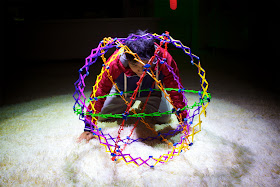 |
| David Whitney as Henry IV |
 |
| Arky Michael, Felix Joseps, Yalin Ozucelik, Matthew Moore, John Bell, Terry Bader, Wendy Strehlow |
 |
| Jason Klarwein as Hotspur, Matthew Moor as Prince Hal |
 |
| John Bell as Fir John Falstaff |
 |
| Matthew Moore as Prince Hal |
 |
| Yalin Ozucelik, Matthew Moore, John Bell, Felix Joseps, Wendy Strehlow, Terry Bader, Arky Michael |
Henry 4 adapted by John Bell from Henry IV Parts 1 and 2 by William Shakespeare. Bell Shakespeare Company, co-directed by John Bell and Damien Ryan, at Canberra Playhouse, February 26 – March 9, 2013.
Reviewed by Frank McKone
February 26
If this version of the Henry IV plays were a game of soccer (I’ve read that the Romans brought football to Britain, and it has flourished there ever since), I think the score would be Sir John Falstaff 7, Prince Hal 2. Or maybe, sympathy for The People 5, appreciation of The Royals 0.
John Bell has selected material, directed the action and played the role himself so that the play seems to owe too much to Falstaff’s grandiose sense of his own importance.
This is not to say that Bell’s interpretation of Falstaff is at fault: in fact, I would say it is probably the best I can recall. We see the full flowering of Falstaff, the con man, who uses all and sundry for his own benefit – and finally faces his justified come-uppance as the new king rejects his fawning attempt to gain high office.
But the focus on the ordinary people weakened the importance – and the audience’s understanding – of the internecine warfare among the nobility, which in the end was Shakespeare’s real concern.
It is the speech by Rumour, “painted full of tongues” – which opens The Second Part of King Henry the Fourth – which links the two parts. The whole society is torn apart by Rumour which “is a pipe / Blown by surmises, jealousies, conjectures, / And of so easy and so plain a stop / That the blunt monster with uncounted heads, / The still-discordant wavering multitude, / Can play upon it.”
I can see Bell’s intention and some reasoning behind the setting of the play in a kind of modern England torn by the social strife of the recent riots, but Shakespeare set his play at a specific point in history, some 200 years before his own time, as a warning, I suggest, to those taking revenge on the basis of the rumour mill. It’s probably more appropriate to see the parallel with our current parliament and the upcoming election, than to see much connection with the street-level destructive behaviour of the modern riots, just because Shakespeare used low-life scenes as comic contrast.
The most significant failure, to me, of this production was that the playing of Prince Hal lost the charisma, intelligence and strategic thinking which is central to his character. Either Matthew Moore was not up to the part – and indeed much of his dialogue was not even to be clearly heard – or it was not considered necessary in the play’s direction to make sure that his words came through to us not as mere banter or drug-induced mish-mash.
For example, when his father is ill, Hal says to Poins “By this hand, though thinkest me as far in the devil’s book as thou and Falstaff for obduracy and persistency: let the end try the man. But I tell thee my heart bleeds inwardly that my father is so sick; and keeping such vile company as thou art hath in reason taken from me all ostentation of sorrow.” He goes on to make clear that he has to think strategically about how “every man would think me an hypocrite indeed”.
I can only fairly report that none of this text was delivered powerfully, so that we would understand how it could be that this apparently dissolute young man could turn around when necessary to defeat the Percy opposition, could face up to the responsibility his father’s illness and subsequent demise would place upon him, and show the kind of strength of character that would be seen by his brother John of Lancaster, now the Lord Chief Justice, when he says, as the play concludes, “I like this fair proceeding of the king’s. / He hath intent his wonted followers / Shall all be very well provided for; / But all are banish’d till their conversations / Appear more wise and modest to the world.”
Where was this strength of character and Hal’s ability to see through the “devil’s book” of Poins and Falstaff, while also understanding their humanity, which takes him on to become the Henry the Fifth of Agincourt? I’m afraid it just wasn’t there.
So, despite the success of the playing of Falstaff, the failure of Prince Hal to score left me disappointed with Henry 4.


















